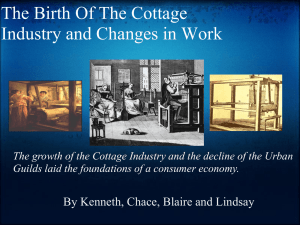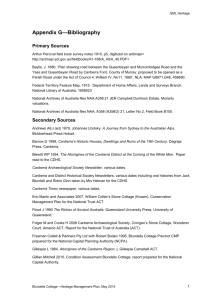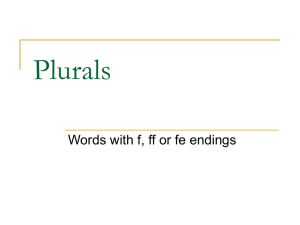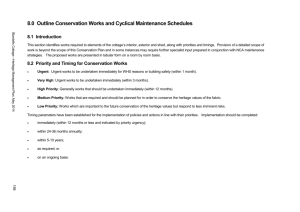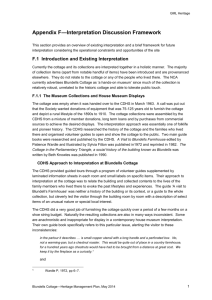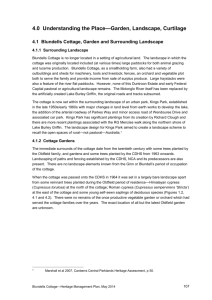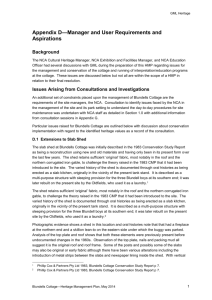00. Blundells Cottage HMP - Executive Summary
advertisement
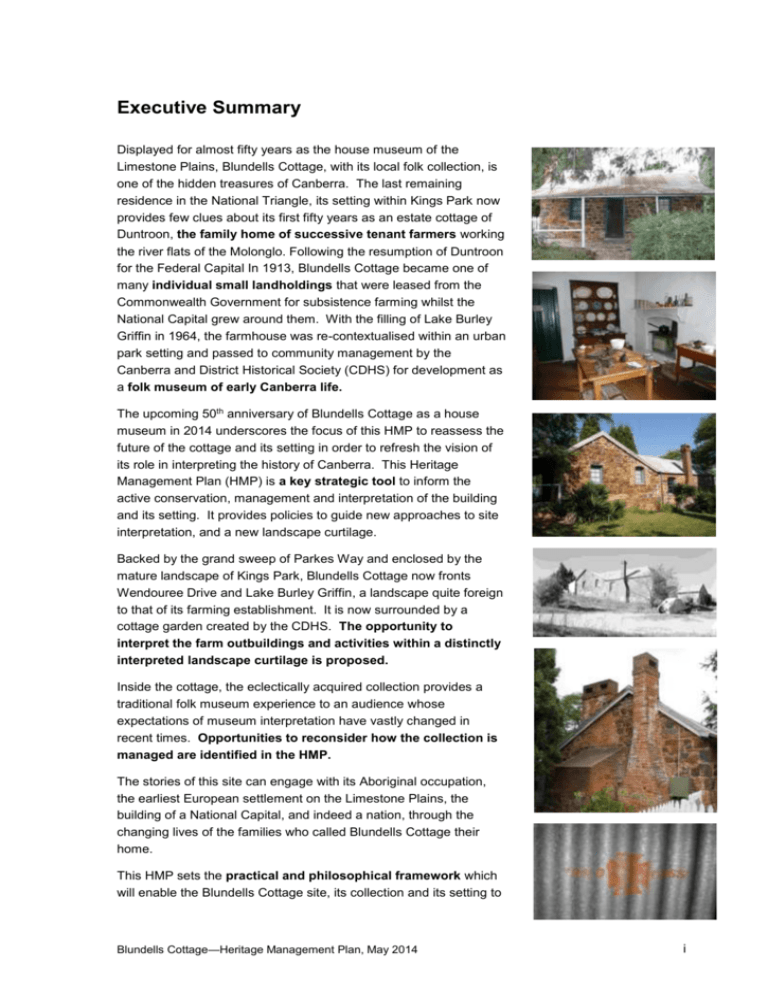
Executive Summary Displayed for almost fifty years as the house museum of the Limestone Plains, Blundells Cottage, with its local folk collection, is one of the hidden treasures of Canberra. The last remaining residence in the National Triangle, its setting within Kings Park now provides few clues about its first fifty years as an estate cottage of Duntroon, the family home of successive tenant farmers working the river flats of the Molonglo. Following the resumption of Duntroon for the Federal Capital In 1913, Blundells Cottage became one of many individual small landholdings that were leased from the Commonwealth Government for subsistence farming whilst the National Capital grew around them. With the filling of Lake Burley Griffin in 1964, the farmhouse was re-contextualised within an urban park setting and passed to community management by the Canberra and District Historical Society (CDHS) for development as a folk museum of early Canberra life. The upcoming 50th anniversary of Blundells Cottage as a house museum in 2014 underscores the focus of this HMP to reassess the future of the cottage and its setting in order to refresh the vision of its role in interpreting the history of Canberra. This Heritage Management Plan (HMP) is a key strategic tool to inform the active conservation, management and interpretation of the building and its setting. It provides policies to guide new approaches to site interpretation, and a new landscape curtilage. Backed by the grand sweep of Parkes Way and enclosed by the mature landscape of Kings Park, Blundells Cottage now fronts Wendouree Drive and Lake Burley Griffin, a landscape quite foreign to that of its farming establishment. It is now surrounded by a cottage garden created by the CDHS. The opportunity to interpret the farm outbuildings and activities within a distinctly interpreted landscape curtilage is proposed. Inside the cottage, the eclectically acquired collection provides a traditional folk museum experience to an audience whose expectations of museum interpretation have vastly changed in recent times. Opportunities to reconsider how the collection is managed are identified in the HMP. The stories of this site can engage with its Aboriginal occupation, the earliest European settlement on the Limestone Plains, the building of a National Capital, and indeed a nation, through the changing lives of the families who called Blundells Cottage their home. This HMP sets the practical and philosophical framework which will enable the Blundells Cottage site, its collection and its setting to Blundells Cottage—Heritage Management Plan, May 2014 i GML Heritage be conserved, managed and re-interpreted. It is based on the significance-led philosophy of the Australia ICOMOS Burra Charter, which informs its recommendations about conservation works, policy and interpretation. Applying standard assessment criteria, the HMP has reviewed and summarised the history and physical evidence of the site. It confirms that Blundells Cottage is an important heritage place with significant heritage values and attributes, for its early colonial tenant farming history, the early Federal Capital phase and for its role as a folk museum since the 1960s. A summary history of the site and the cottage residents is provided at Section 2.0 which has supported the analysis of the phases of development of the cottage and its setting. A thorough description of the physical evidence of the site is at Sections 3.0 and 4.0, and has contributed to the development of a statement of significance for the property at Section 5.0. The constraints and opportunities that arise both from the legislative context, the site’s significance and its conservation and practical management needs are explored in Section 6.0. Standard and specific conservation policies and actions provide clear direction for the site in Section 7.0. A schedule of conservation works and a cyclical maintenance plan is provided in section 8.0. Urgent works are specifically identified to resolve water penetration and drainage problems as well as potential insect pests. The major issues that require resolution and long-term decisions by NCA include: defining and managing a distinct heritage curtilage for the site for the cottage, slab shed and the location and options for reinstating and/or interpreting former associated outbuildings, plantings and fencing through the development of a Landscape Masterplan, and to support museum interpretation, visitor infrastructure and operational needs; committing resources to a program of conservation maintenance works, especially in relation to resolving the water penetration problems of the building; developing and refining a Collections Significance Assessment and Collections Management Policy and a new approach to collection use; and completing the re-discovery of the site’s potential through the development and implementation of a detailed Interpretation Strategy and Implementation Plan following on from the Interpretation Discussion Framework in Appendix F. This HMP has been developed in consultation with key ii Blundells Cottage—Heritage Management Plan, May 2014 stakeholders including site managers, heritage interests, and Indigenous and education stakeholders. Specific site management issues needing speedy attention were raised through the analysis of management and user requirements and aspirations. Key issues included museum visitor services, disabled access and tree management, as well as several reconstruction/interpretation projects. These are discussed in Appendix D. Lastly, but crucially, this HMP complies with the requirements of Schedules 7A and 7B of the EPBC Act. Compliance tables are included in Appendix B. Blundells Cottage—Heritage Management Plan, May 2014 iii GML Heritage iv Blundells Cottage—Heritage Management Plan, May 2014

